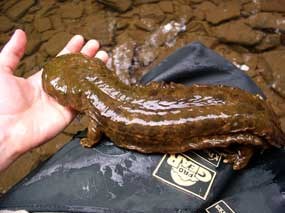
Jeff Humphries “Allegheny Alligators” “snot otters” “devil dogs” All of these vividly descriptive commonly used names are describing the same creature, the giant salamander of the Appalachian Mountains known as the hellbender (Crytobranchus alleganiensis). All of the common names describe some aspect, either fact or fiction, about the hellbender. The hellbender is truly a giant; they can grow to over two feet long. Hellbenders, with their wrinkled, greenish brown and slimy skin, are not pretty to look at, and they are still trying the live down the myth that they possess a venomous bite and are wanton killers of game fish. Hellbender habitat is a cool, clear and clean creek or river with a rocky streambed. This habitat is vital to hellbenders because they are totally aquatic, breathing entirely through their skin. They are nocturnal and spend the days sheltering under rocks. Male hellbenders also build hollowed nests under rocks to court females to mate, and then guard the eggs until they hatch. They are predators, and their prey is primarily crayfish. Hellbender sightings are becoming rare and biologists are concerned about the decline in populations and quality stream habitats. In West Virginia hellbenders are a species of special concern and cannot be collected, and assessments are being made to determine if hellbenders qualify for protection under the Endangered Species Act. Many hellbenders are still killed by fishermen due to the false beliefs about venomous bites and fish predation impacts. The hellbender, like all amphibians is an excellent indicator of the health of the ecosystem that is its home. In the case of the hellbender the quality of the water is the prime factor in the preservation of the species. Soil erosion and siltation, chemical, agricultural and acidic mine runoff, high bacteria counts, and low oxygen levels all combine to threaten stream ecosystems for a single species such as a hellbender, and eventually all the life that relies on water for survival; which is all life!
In 2017, park researchers collected water samples from major tributaries to the New River and Bluestone River to be tested for the presence of hellbender DNA. Water from the streams was pumped through a sterilized filter that was then analyzed with a very sensitive test that detects very small amounts of DNA. The sampling was done in early autumn, which is hellbender mating season. This is the best time to collect and analyze the water samples because hellbender activity increases at this time of year, which gives a better chance of detecting their DNA in the water. When the data results came back only one stream in the New River Gorge National Park and Preserve showed a positive detection. This year researchers will repeat the sampling in a set of major tributaries to the Gauley and Meadow Rivers. Our four protected river areas, their tributaries and combined watersheds cover a large area of the Southern Appalachians, the prime habitat for the hellbender. The species research and water quality monitoring we do, like the hellbender themselves, can warn us of threats to one of the most biologically diverse regions on the earth. Whether the hellbender continues to survive and be seen by future generations in our New, Bluestone, Gauley and Meadow Rivers watershed, or any river and stream ecosystem remains, at this time, in question. |
Last updated: January 27, 2021
